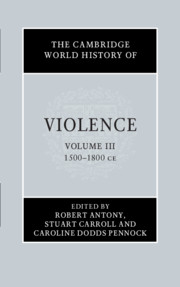Book contents
- The Cambridge World History of Violence
- The Cambridge World History of Violence
- The Cambridge World History of Violence
- Copyright page
- Contents
- Figures
- Maps
- Contributors to Volume iii
- Introduction to Volume iii
- Part I Empire, Race and Ethnicity
- Part II Cultures of War and Violence
- 6 Chinese Ways of Warfare
- 7 The Wars of Invasion in the Caribbean and Mesoamerica, 1492–1547
- 8 The Yogi’s Way of War
- 9 Warfare in Europe
- 10 War, State and the Privatisation of Violence in the Ottoman Empire
- Part III Intimate and Gendered Violence
- Part IV The State, Punishment and Justice
- Part V Popular Protest and Resistance
- Part VI Religious and Sacred Violence
- Part VII Representations and Constructions of Violence
- Index
- References
6 - Chinese Ways of Warfare
from Part II - Cultures of War and Violence
Published online by Cambridge University Press: 13 March 2020
- The Cambridge World History of Violence
- The Cambridge World History of Violence
- The Cambridge World History of Violence
- Copyright page
- Contents
- Figures
- Maps
- Contributors to Volume iii
- Introduction to Volume iii
- Part I Empire, Race and Ethnicity
- Part II Cultures of War and Violence
- 6 Chinese Ways of Warfare
- 7 The Wars of Invasion in the Caribbean and Mesoamerica, 1492–1547
- 8 The Yogi’s Way of War
- 9 Warfare in Europe
- 10 War, State and the Privatisation of Violence in the Ottoman Empire
- Part III Intimate and Gendered Violence
- Part IV The State, Punishment and Justice
- Part V Popular Protest and Resistance
- Part VI Religious and Sacred Violence
- Part VII Representations and Constructions of Violence
- Index
- References
Summary
This chapter offers an overview of Chinese warfare, c. 1500–1800, with an emphasis upon the way in which state-sponsored violence was deployed to counter the multitude of strategic threats faced by the Ming and Qing dynasties. It highlights the role of violence in maintaining and extending the power and legitimacy of the imperial Chinese state. For even if Chinese dynasties were wont to extol Confucian values of benevolence and pacifism, the harsh reality was that state-sponsored violence was generally the key to maintaining authority, both domestically and in the broader East Asian world. The chapter shows how recent secondary studies have explored many dimensions of China’s martial culture and how these studies in turn illuminate the array of military challenges that faced all Chinese dynasties. It offers a typology of military threats and situates them specifically within the late imperial Chinese context. Central to this analysis is the massive size and ethnic diversity of the empire, which posed unique challenges to the rulers and their military establishments. The chapter also offers suggestions for future work and comparative studies.
Keywords
- Type
- Chapter
- Information
- The Cambridge World History of Violence , pp. 119 - 137Publisher: Cambridge University PressPrint publication year: 2020
References
Bibliographic Essay
- 1
- Cited by

